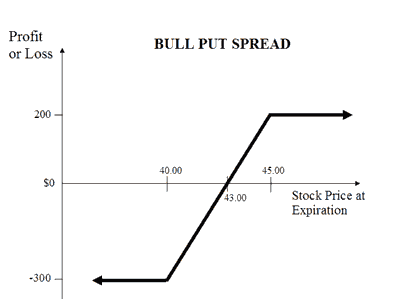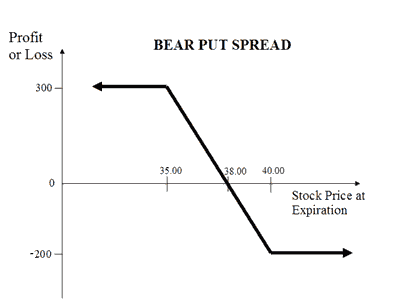 Zerodha (Trading & Demat Account)
Zerodha (Trading & Demat Account)
FREE Equity Delivery and MF
Flat ₹20/trade Intra-day/F&O
 Zerodha (Trading & Demat Account)
Zerodha (Trading & Demat Account)
FREE Equity Delivery and MF
Flat ₹20/trade Intra-day/F&O

|
|
Compare Bull Put Spread and Bear Put Spread options trading strategies. Find similarities and differences between Bull Put Spread and Bear Put Spread strategies. Find the best options trading strategy for your trading needs.
| Bull Put Spread | Bear Put Spread | |
|---|---|---|
 |
 |
|
| About Strategy | A Bull Put Spread (or Bull Put Credit Spread) strategy is a Bullish strategy to be used when you're expecting the price of the underlying instrument to mildly rise or be less volatile. The strategy involves buying a Put Option and selling a Put Option at different strike prices. The risk and reward for this strategy is limited. A Bull Put Strategy involves Buy OTM Put Option and Sell ITM Put Option. For example, If you are of the view that the price of Reliance Shares will moderately gain or drop its volatility in near future. If Reliance is currently trading at Rs 600 then you will buy an OTM Put Option at Rs 700 and a sell an ITM Put Option at Rs 550. You will make a profit when, at expiry, Reliance closes at Rs 700 level and incur losse... Read More | The Bear Put strategy involves selling a Put Option while simultaneously buying a Put option. Contrary to Bear Call Spread, here you pay the higher premium and receive the lower premium. So there is a net debit in premium. Your risk is capped at the difference in premiums while your profit will be limited to the difference in strike prices of Put Option minus net premiums. This strategy is used when the trader believes that the price of underlying asset will go down moderately. This strategy is also known as the bear put debit spread as a net debit is taken upon entering the trade. This strategy has a limited risk as well as limited rewards. How to use the bear put spread options strategy? The bear put spread strategy looks like... Read More |
| Market View | Bullish | Bearish |
| Strategy Level | Advance | Advance |
| Options Type | Put | Put |
| Number of Positions | 2 | 2 |
| Risk Profile | Limited | Limited |
| Reward Profile | Limited | Limited |
| Breakeven Point | Strike price of short put - net premium paid | Strike Price of Long Put - Net Premium |
| Bull Put Spread | Bear Put Spread | |
|---|---|---|
| When to use? | This strategy works well when you're of the view that the price of a particular underlying will rise, move sideways, or marginally fall. |
The bear call spread options strategy is used when you are bearish in market view. The strategy minimizes your risk in the event of prime movements going against your expectations. |
| Market View | Bullish When you are expecting a moderate rise in the price of the underlying or less volatility. |
Bearish When you are expecting the price of the underlying to moderately drop. |
| Action |
A Bull Put Strategy involves Buy OTM Put Option + Sell ITM Put Option. For example, If you are of the view that the price of Reliance Shares will moderately gain or drop its volatility in near future. If Reliance is currently trading at 600 then you will buy a OTM PUT OPTION at 700 and a sell a ITM PUT OPTION at 550. You will make a profit when at expiry Reliance closes at 700 level and incur losses if the prices fall down below the current price. |
|
| Breakeven Point | Strike price of short put - net premium paid |
Strike Price of Long Put - Net Premium The breakeven point is achieved when the price of the underlying is equal to strike price of long Put minus net premium. |
| Bull Put Spread | Bear Put Spread | |
|---|---|---|
| Risks | Limited Maximum loss occurs when the stock price moves below the lower strike price on expiration date. Max Loss = (Strike Price Put 1 - Strike Price of Put 2) - Net Premium Received Max Loss Occurs When Price of Underlying <= Strike Price of Long Put |
Limited The maximum loss is limited to net premium paid. It occurs when the price of the underlying is less than strike price of long Put.. Max Loss = Net Premium Paid. |
| Rewards | Limited Maximum profit happens when the price of the underlying moves above the strike price of Short Put on expiration date. Max Profit = Net Premium Received |
Limited The maximum profit is achieved when the strike price of short Put is greater than the price of the underlying.. Max Profit = Strike Price of Long Put - Strike Price of Short Put - Net Premium Paid. |
| Maximum Profit Scenario | Both options unexercised |
Underlying goes down and both options exercised |
| Maximum Loss Scenario | Both options exercised |
Underlying goes up and both options not exercised |
| Bull Put Spread | Bear Put Spread | |
|---|---|---|
| Advantages | Allows you to benefit from time decay in profit situations. Helps you profit from 3 scenarios: rise, sideway movements and marginal fall of the underlying. |
Risk is limited. It reduces the cost of investment. |
| Disadvantage | Limited profit. Time decay may go against you in loss situations. |
The profit is limited. |
| Simillar Strategies | Bull Call Spread, Bear Put Spread, Collar | Bear Call Spread, Bull Call Spread |

Add a public comment...

FREE Intraday Trading (Eq, F&O)
Flat ₹20 Per Trade in F&O
|
|